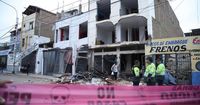On the night of August 14, 2025, the northern Peruvian city of Trujillo was rocked by a powerful explosion that left at least 10 people injured and damaged 25 homes. The blast, which disrupted electricity and affected several vehicles, has intensified concerns about the escalating violence driven by organized crime in the region. According to the Associated Press, the explosion occurred on a street in Trujillo, a city already plagued by frequent clashes among criminal groups vying for control over extortion rackets.
Interior Minister Carlos Malaver addressed the nation on Friday, stating that the explosion "could be related to disputes between criminal groups primarily involved in extortion, one of the crimes that has increased the most in Peru in recent years." His comments, echoed across several news agencies including AP and OneIndia, highlight the growing influence—and violence—of organized crime in Peru’s northern regions.
The blast in Trujillo was not an isolated incident. Earlier that same day, another explosion occurred at a gym in Lima, Peru’s capital. While no injuries were reported in the Lima blast, the two attacks in a single day have sent shockwaves through the country. The Trujillo explosion, however, was far more destructive, injuring at least 10 people—some suffering burns and cuts, according to the state’s emergency service agency—and damaging dozens of homes. The precise condition of the injured has not been detailed, but ambulances and emergency personnel responded swiftly to the scene.
Electric service in the affected area was interrupted, compounding the chaos and making rescue efforts more difficult. Several vehicles were also damaged, though the exact number remains unknown. Residents described scenes of panic as the explosion tore through the neighborhood, shattering windows and leaving families scrambling to find safety. The incident, as reported by Devdiscourse and other outlets, is part of a disturbing trend: explosive attacks, especially those targeting small businesses and public transportation, are becoming alarmingly commonplace in Trujillo and other cities across Peru, including Lima and the wider La Libertad region.
Local media have reported that detonations inside public transportation buses have also caused injuries in recent months. The government of La Libertad, the state encompassing Trujillo, has previously acknowledged that crime sometimes overwhelms police capacity. As the state’s emergency service agency noted in its Friday statement, the ongoing violence has become a significant threat to public safety and stability.
Behind the violence lies a surge in extortion-related crime. Official data released by Peruvian authorities paints a grim picture: from January to July 2025, extortion complaints totaled 15,989—a staggering 28% increase compared to the same period in 2024. Interior Minister Malaver emphasized that these criminal groups are primarily responsible for the wave of violence, with disputes over territory and illicit profits fueling the attacks. "The blast might be tied to conflict among criminal groups, mainly involved in extortion—a crime on the rise in Peru," Malaver explained, as cited by multiple sources including AP and Devdiscourse.
For many residents of Trujillo, the explosion was the latest in a series of traumatic events. Local authorities and emergency responders worked through the night to secure the area, restore electricity, and assist the injured. The damage to homes has displaced families, adding to the sense of insecurity that now permeates daily life in the city. “Some of the people injured in Thursday’s blast suffered burns and cuts,” the state’s emergency service agency reported, but further details on their conditions were not provided. The blast’s impact was felt not just physically but psychologically, with many residents expressing fear that such violence could become the new normal.
Peru’s crime crisis is not limited to Trujillo. Explosive attacks are reported almost daily by local media in Lima and other cities, with small businesses often targeted by extortionists seeking protection money. Public transportation, too, has been hit—detonations inside buses have left passengers injured and commuters wary. The scale and frequency of these attacks have overwhelmed local law enforcement, and the government of La Libertad has openly admitted that police resources are sometimes insufficient to stem the tide of crime.
The rise in extortion is particularly alarming. According to official statistics, the 28% year-on-year increase in complaints from January to July 2025 marks one of the sharpest surges in recent memory. Criminal organizations, emboldened by weak enforcement and lucrative returns, have expanded their operations, targeting not just businesses but ordinary citizens. The violence has forced many to reconsider their livelihoods and daily routines, with some small business owners closing shop rather than risk becoming the next target.
Authorities are under mounting pressure to act. The dual explosions on August 14 have galvanized calls for a more robust response to organized crime. Interior Minister Malaver and other officials have pledged to step up efforts to dismantle criminal networks and improve public safety, but the challenges are formidable. In Trujillo and elsewhere, law enforcement faces not only heavily armed gangs but also public skepticism about the state’s ability to protect its citizens.
For now, the people of Trujillo and other affected regions are left to pick up the pieces. Emergency crews continue to assess the damage, while hospitals treat the injured and families seek shelter. The specter of further violence hangs over the community, with many wondering when—and if—the cycle of attacks will end. The events of August 14, 2025, serve as a stark reminder of the urgent need for effective measures to combat organized crime and restore a sense of safety to Peru’s streets.
As the nation grapples with this surge in violence, one thing is clear: the fight against organized crime and extortion will require not only stronger law enforcement but also a concerted effort to address the root causes of criminality. For the residents of Trujillo and beyond, the hope is that decisive action will bring lasting peace—and that the scars of this latest tragedy will not be repeated.

